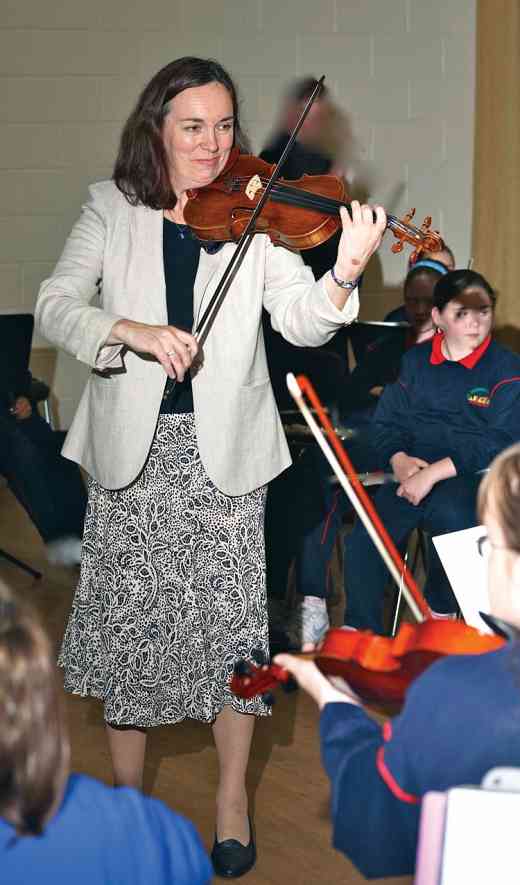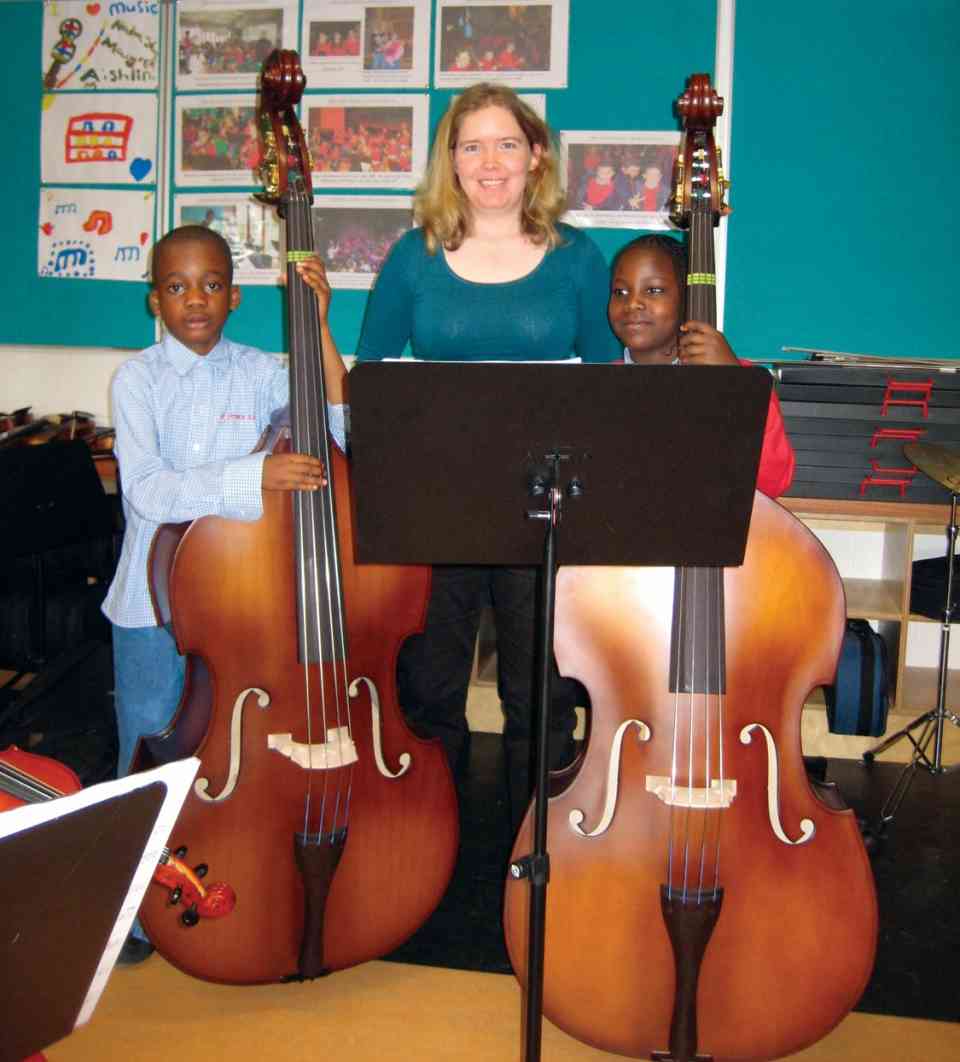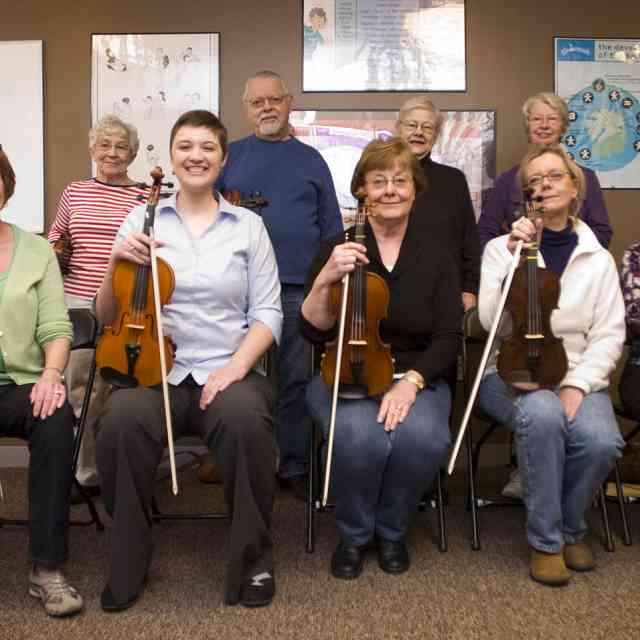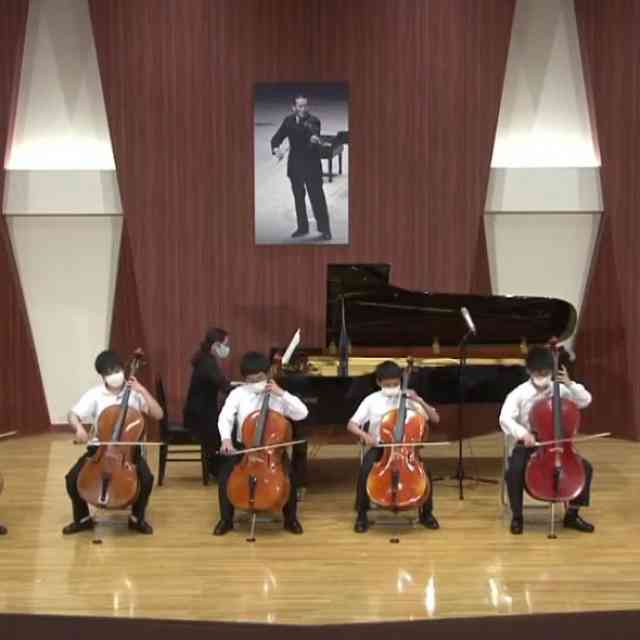
Student violinists from Saint Ultans Cherry Orchard
When I arrived at St. Joseph’s National School in the north of Dublin, Ireland, early one morning about five years ago, I had very little idea what to expect.
Dorothy Conaghan, whom I had met a few years earlier while teaching at a Suzuki workshop in France, had invited me to visit this school in the economically challenged district of Ballymun. By the end of an unforgettable day of music, I knew that I definitely wanted to find a way to return, again and again.
At eight in the morning, Dorothy and Brian Clarke, the charismatic principal of St. Joseph’s, introduced me to the student string group and to the teachers who work regularly with the children. Dorothy put the children, ages seven to twelve, through their paces, working on their playing position, rhythm and tone. The group rehearsed pieces they had already learned, then Dorothy introduced new music, much of which was based on the Twinkle rhythms. During the class, I learned some new words for Variation A—“four and twenty black-birds.” I had naively thought I was simply there to observe, but with Dorothy, everyone gets put to work, and before I knew it, I was involved. Sometimes she handed me her violin so I could work with the children, sometimes I played piano with the group. I will always remember the joy and pride on the faces of those children as they performed their orchestra pieces for me.
The only requirement for the children to take part in the string program was their promise to come in at eight every morning for music class. After playing, the children were given a hot breakfast before the start of their regular school schedule. For many of the children, this would be their best meal of the day.
Later that day, Dorothy and I met more children and teachers as we visited two additional schools—Holy Spirit Girls’ School, also in Ballymun, and St. Agnes’ School in Crumlin, an inner-city Dublin neighborhood with a similar socio-economic situation. I saw the same excitement and pride glowing on the faces of the children, who knew that their ability to play music was something very special.
Watching Dorothy work with the children is inspiring. She is a dynamo, glowing with positive energy. She encourages the children as they play, but continually challenges them for tighter rhythm, better ensemble and a more beautiful sound. Her droll sense of humor and her unabated enthusiasm keep the children constantly engaged.

Dorothy Conaghan working with children in Ballymun
Dorothy’s pedagogic skills have evolved through a synthesis of training and experience. She completed all of the levels of Suzuki Violin training in London. After completing her BA and BM degrees, she traveled to Germany to study violin with Dr. Suzuki’s former student Koji Toyoda, the current president of the International Suzuki Association. Dorothy plays violin, viola, and cello, and has worked as head of music in a Dublin secondary school and taught musicianship in the Conservatory of Music in Dublin. For more than twenty-five years she has nurtured students through her private Suzuki studio and has directed the Young Dublin Symphonia, a chamber orchestra for her advanced Suzuki students.
Unlike the SAA, the European Suzuki Association does not yet have a formal Suzuki in the Schools curriculum. Dorothy is a pioneer of school string teaching in Ireland. For more than five years before my first visit, she had been working in economically challenged areas of the country. She is currently involved in twelve schools in different parts of Ireland. Her work in school strings projects was in part inspired by El Sistema, which for over three decades has attracted high-risk youth in Venezuela to classical music instead of drugs and crime. She has also been influenced by Suzuki-based school string programs in North America such as those in inner-city areas of Texas and New York.
In the school programs which Dorothy oversees, the children pay nothing for their instruments, books or tuition. Instruction is given by musicians from the community who are hired to come into the school. Dorothy visits the schools regularly, demonstrating techniques for working with the children, observing the teachers at work, and offering suggestions for further development of their teaching skills.
When a school principal contacts Dorothy about starting a string program, she loads her car up with violins (on loan from the National Concert Hall of Ireland) and gives teaching demonstrations for up to twenty children at a time. Potential sponsors such as parish priests, parent association representatives, business people and local politicians are often invited to observe these demonstrations. Because Ireland has no public funding for either private or school-based music lessons, each school must raise the money for teachers, instruments, music and equipment.
During one of these demonstrations, Dorothy discovered two sisters from eastern Europe who were accomplished violinists, but whose parents cannot afford violins or lessons. She has left a violin in the principal’s office so they can practice, and each time she passes by the school she stops in and hears them play.
Some schools now include a “Baby Bows” program for the youngest children in the school, the four to six-year-olds. It is what Dorothy calls “preparing little kids for big music.” She runs a weekend “boot camp” for their classroom teachers at the beginning of the school year. The teachers learn the basics of bow holds, violin holds, and the Twinkle rhythms so that they can take on the role of practice partners with the children during school time. The children are given dowels and sponges (for violin holds), then later, box violins, on which they learn the basics of posture and rhythm. They listen to and pattern the rhythms with the Suzuki CD and with my compositions from Magic Carpet. This class prepares the children for the regular string programs. At the same time, it helps the schools with funding by involving the classroom teachers on days when the music teacher is not in the school.
Since my first visit to Ballymun, I have been fortunate to be able to return to Ireland several times to visit school music programs. In 2007, just before Brian Clarke’s retirement from St. Joseph’s School, I was able to attend a end-of-term gala concert with performances by the parent’s violin class, an orchestra with children from several schools, a school choir, and a band from neighboring schools—truly a memorable occasion.
Thanks to Dorothy, I have had the honor of being awarded two very exciting commissions in Dublin. The first was premiered in 2008, when National Concert Hall funded the commission for me to write the “Dublin Suite” for string orchestra. The suite consists of three movements, each with a Dublin-inspired title: “Crumlin Polka,” “Evening on the Liffey,” and “Ballymun Dance.” At the premiere performance, Dorothy conducted the Dublin Children’s Orchestra. Three schools in at-risk areas came together to form this orchestra, playing violin, viola, cello and bass. The school groups were joined by members of Irish Youth Orchestra. It was a gala occasion, attended by the Irish Minister of Education. The audience included many proud parents, most of whom were in the concert hall for the first time in their lives. The youngsters’ eyes were wide with astonishment at the elegance of the National Concert Hall, with its deep red carpets and Waterford crystal chandeliers, which could scarcely be more different from their own neighborhoods. The children felt honored at this opportunity, they were inspired by the more advanced players and by the occasion, and they played their hearts out for the enthusiastic audience.

Two beginning bassists from Saint Ultans Cherry orchard with bass teacher Eimear Saunders
The second project was commissioned by Saint Ultans Primary School Cherry Orchard to celebrate the official opening of their new school building in June 2011. “The Circus Suite” for strings and percussion has four movements, each with a circus theme, and each featuring a different section of the orchestra. In addition, as part of the Saint Ultans commission, the school’s principal, Ena Morley, asked me to compose a school song. The staff and students wrote the lyrics, which describe a joyful community as the children learn together. Ena told me that she frequently hears the children enthusiastically singing “their” song in the corridors and in the playground. Here are the lyrics to the chorus:
Feel the rhythm in Cherry Orchard
Bow it softly, then stamp your feet!
Cherry Orchard, we’re all together
Side by side in harmony!
While I was in Canada or in France writing the music for these commissions, I could visualize the faces of the children I met. Having worked with them, I knew what technical and musical level they could handle. For the beginners, I wrote very easy string parts, which use mostly open strings. These easy parts use the same rhythms as the more advanced orchestra parts, and soon the beginners will be ready to play the regular orchestra parts.
Saint Ultans Cherry Orchard is a unique community. As well as the primary school, there are also baby, toddler, early education, and after-school programs. Late in the afternoon, teenage girls in their school uniforms pick up their children, who have spent the day in the baby or toddler programs. The music program now includes a parents’ string class and a Cherry Orchard community orchestra.
In the orchestra room at Saint Ultans, as in the other schools I have visited, the children are respectful and eager to learn. They feel real pride at what they can already do, and are highly motivated to achieve even more. I personally feel honored to have had the chance to experience these school programs first-hand, and I am convinced that the spirit of Dr. Suzuki is truly present in these classrooms.
Dorothy Conaghan’s music programs are developing a proud sense of community within the schools, with children and parents brought together through the medium of classical music. Many of the schools now have parent classes. When the children perform the audience is full of delighted parents. In some schools, the older children have spontaneously started helping the younger ones with their lunchtime practice. In each school I have visited, principals and teachers have told me that they had been concerned about increasing discipline problems, but now that every child plays a musical instrument, they have seen significant improvement in the children’s attitudes and behavior.
These string programs have enriched the lives of more than 3,000 children in socio-economically challenged neighbourhoods—children who otherwise would have no possibility of music lessons. The National Concert Hall of Ireland has generously provided funding for Dorothy’s school visits to coordinate programs and to train and mentor teachers, and she is grateful for this support, as well as to the Arts Council of Ireland for grants to assist her research travel. As and when additional, ongoing funding becomes available, it will be possible to train and hire more music teachers and to expand the strings project to other needy schools. Dorothy’s dream, and my own fervent wish, is for the day when there can be Suzuki in the Schools training for every teacher and instrumental music lessons for every student in every school in Ireland.
In an email discussion about the school programs, Dorothy wrote, “The Suzuki philosophy was and is my inspiration, and with that, one can do anything.” The Suzuki philosophy seems especially powerful in neighborhoods where families are so limited financially and where merely finding adequate food and lodging are a challenge. These school music programs truly nurture the children with love, and they develop the potential in each child to learn, to achieve success through work, and to become fine human beings.








